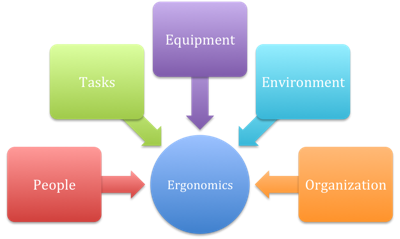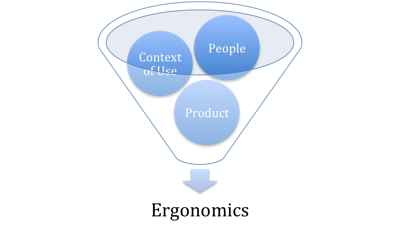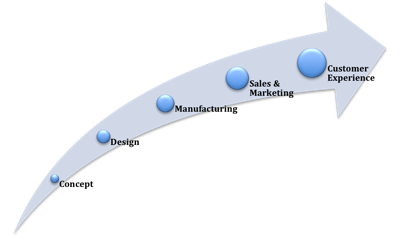[Editor’s Note: This article is PART 2 of a series that began with Towards a Credible Ergonomics Certification for Products and Processes: PART 1]
In PART 1 of this series, I provided some background to the question of whether it’s a good idea to pursue a credible certification system for ergonomics in product and process design, how that might be accomplished, and some of the challenges and pitfalls that would need to be overcome. In this article I’ll introduce some models that could underpin such a certification process, giving it a firm foundation in ergonomics theory, application and end-user experience.
First, let’s tackle the question of a definition. There are many definitions for ergonomics (noun) floating around, but for the purposes of credibility and consensus, I submit it’s best to start with a widely accepted definition. The definition can mature or change with time, but as a starting point, let’s turn to the International Ergonomics Association (IEA):
Ergonomics (or human factors) is the scientific discipline concerned with the understanding of interactions among humans and other elements of a system, and the profession that applies theory, principles, data and methods to design in order to optimize human well-being and overall system performance.
Right away we’re faced with a potential point of confusion … is it “ergonomics”, or is it “human factors”? This remains a point of contention among veterans of the industry, but I submit, at least in the public’s mind, ergonomics is far more widely known and understood than is human factors. Unfortunately, the USA public’s understanding of the meaning of ergonomics has been somewhat skewed by the prominent political debate surrounding workplace/occupational ergonomics, which is fuel for the fire in professional debates, because many ergonomics applications have little or nothing to do with the workplace or with work-related musculoskeletal disorders (WMSDs). I submit that it’s time to move beyond this debate and regain control over our own word, ergonomics, and product and process certification could play an important role in that forward progress.
Parsing the key points from the above definition and rearranging them in a form suitable for terminology like ergonomic (adjective), as in “this product is ergonomic”, or ergonomically (adverb), as in “this product is ergonomically designed,” we have a starting place: To be ergonomic, or ergonomically designed, a product or process must:
- have feature(s) that are grounded by scientific theory, principles, data and methods;
- that evidence must apply to the interactions among the user(s) and other elements of the system; and
- the outcome(s) must serve to optimize human well-being and overall system performance.
Many argue that there can be no such thing as an ergonomic/ergonomically designed product, because the interactions among humans and other elements of the system are uncontrollable by the designer. It’s the context of use, they argue, that defines ergonomics, not the product alone. The classic example is the awkward elbow abduction posture (“chicken wing”) a person exhibits while using a pistol-grip shaped power tool while working on a horizontal, elevated surface. A bent tool handle in and of itself is not ergonomic; instead, ergonomics is achieved only when that bend reduces or eliminates awkward posture, which depends entirely on how it is used by the person.

A model showing that the interactions between people and other elements of a system define whether or not something is ergonomic, or ergonomically designed.
While that’s true, other industries have successfully surmounted the context of use challenge. The ubiquitous UL certification label, for example, is issued to the common household wall-mounted electrical outlet, even though a person could still be electrocuted by inserting conductive material into the outlet. The UL approval doesn’t guarantee safety or safe use, but it does demonstrate that the manufacturer complied with accepted design practices that substantially limit the possibility that someone will be electrocuted during normal use.
Unlike the UL label, however, context of use plays an even larger role in determining whether a product is ergonomic. Therefore, I submit, context of use must be a central component in any ergonomics certification system. And since a designer or manufacturer has limited control over how a product is used in the field, this component of the certification system must focus on the efforts taken to control or influence use, such as product accompanying instructional materials, warning labels, or better yet, intuitive use design features. For example, if the pistol-grip tool manufacturer strives for ergonomics certification, then that manufacturer had better take active, documentable, and effective steps to inform users of proper/improper use.

Context of Use plays a key role in determining whether the interactions between users and equipment produce an ergonomic outcome
So, essentially, as a minimum, an ergonomics certification system must evaluate specific product features; how those features optimize well-being and system performance under clearly defined context of use scenarios; and how proper use is communicated to users. The ultimate test should be whether or not the user experience actually matches the intended outcomes of the design features. That is, when the product reaches the user, does it actually deliver the intended ergonomic benefits?
You’ll note that I’ve been referring to both process and product certifications. Process certification could apply to a product design process, or it could apply to other ergonomics-related processes, such as a workplace ergonomics process. I’ll leave the workplace ergonomics process certification to another discussion, and focus herein on product development processes.
Below is a simple model of a design concept-to-user process. In reality, a good design processes is not so linear, and there are lots of design iterations along this path, but from a timeline perspective, this an adequate model.

The design-to-customer process
Many people favor a process certification approach over a product certification. EQUID, which stands for Ergonomics QUality In Design, is an initiative spearheaded by the IEA. I have followed and contributed feedback to this proposed design process certification model since its inception in the early 2000’s, and believe it has progressed to a usable form. I would adopt it, in all or in part, in its current form. In short, EQUID assesses the designer’s recognition, use and application of ergonomics data, methods, and principles during the product design process. It contains the following sections/requirements (from EQUID Design Process Requirements, Version 1.11, December 15, 2008):
1. Organization management and documentation
1.1 Management commitment
1.2 Quality policy, quality objectives, and management planning
1.3 Responsibility, authority, and communication
1.4 Management reviews
1.5 Competence, awareness, and training of human resources
2. User Requirements document(s)
2.1 Initial User Requirements document
2.2 User Requirements Changes
3. Design reviews
3.1 Design and development planning
3.2 Design and development reviews
4. Final ergonomic evaluation report and management decision
4.1 Design and development validation
4.2 Management review of evaluation results compared to the user requirements
5. User satisfaction evaluation reports
5.1 Monitoring and measuring after-sales user satisfaction
5.2 Control of a product that does not conform and corrective actions
5.3 Monitoring and continual improvement
It does include a “user satisfaction” component, but is otherwise limited in its assessment of the final product — the outcome of the design process. I believe EQUID is an excellent first step, and could be a limited process certification system in and of itself. However, I advocate pushing the certification model further into the user experience realm, and including components that recognize the role of ergonomics in manufacturing and sales & marketing processes, all of which can significantly impact the customer experience. Even the best design intentions that apply all the best known data, methods and principles can result in a product with poor user experience, and therefore poor ergonomics.
And what about such things as packaging (wrapper rage, as some have come to call the user experience associated with poor packaging)? There are many facets to a design that optimize human well-being and overall system performance, and I submit that a product certification model that is robust and inclusive is ultimately a stronger, more credible approach. EQUID forms a solid basis to start with, but does not stand alone in the determination of whether a product or process produces the desired user experience.
In the next installment(s) in this series, I’ll expand and add detail to the certification model and walk a product through the process to illustrate how it could work. In the mean time, I welcome your comments, suggestions or concerns.
This article originally appeared in The Ergonomics Report™ on 2011-06-01.
